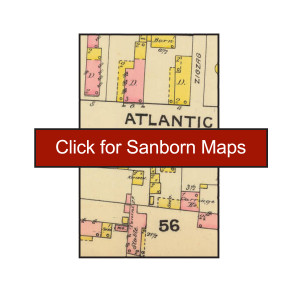“Antebellum industrialist, William Gregg did more than start a cotton mill at Graniteville, S.C.”

Courtesy of Halsey Institute of Contemporary Art: Rick Rhodes – photographer, Ronald Ramsey artist – preservationist, 2017.
City Directories and History: One of several Nassau Street houses associated with Southern industrialist, William Gregg’s – Charleston Cotton Factory housing. Link
here to the Gregg Home on Calhoun Street. This and other workers’ housing was often built in the Gothic Revival style in both Graniteville as well as Charleston. Click on the linked icon (right), for additional data on the Graniteville Mill.
William Gregg (1800-1867) had already had a successful career as a jeweler by the time he became involved in the textile industry in the 1840s. After touring New England and seeing its textile mills and industrial towns, he began advocating that the states of the Southern United States should industrialize to compete economically with the north. Gregg obtained financing from Charleston financiers to establish a model textile business, which would (controversially for the slavery-dominated South) employ white laborers.[1][3]
Between 1845 and 1849 Gregg supervised the construction of a mile-long power canal, drawing water from Horse Creek and Bridge Creek, a mill building, schoolhouse, and 100 Carpenter Gothic wood frame worker housing units (of which 26 survive in good condition). He made available lots of land within the development for the construction of churches, of which two were eventually built. (One of these, St. John’s Methodist Church, is still standing.) The mill was furnished with the most recent technology for spinning and weaving, and went into operation in 1849. The financial success of the enterprise prompted the development of other, similar mills elsewhere in the South. Development was interrupted by the American Civil War, although this facility was one of the mainstays of textile production in the Confederacy. Gregg’s businesses continues to operate today, as Graniteville Specialty Fabrics.[1]
Graniteville is located west of Aiken, on the east side of Horse Creek, a tributary of the Savannah River to the south west. The historic district includes the original 1846 power canal (no longer used for that purpose), which runs north from the center of Graniteville on the west side of Canal Street (South Carolina Highway 191). It also includes the original 1849 mill building, the 1847 Graniteville Academy building, St. John’s Methodist Church, and the surviving line of 1840s worker houses on Gregg Street. Information courtesy of Wikipedia – https://en.wikipedia.org/wiki/Graniteville_Historic_District_(South_Carolina)
Other sources: Charleston Tax Payers of Charleston, SC in 1860-61, Dwelling Houses of Charleston by Alice R.H. Smith – 1917, Charleston 1861 Census Schedule, and a 1872 Bird’s Eye View of Charleston, S.C. The Hist. Charleston Foundation may also have additional data at: Past Perfect
Stay Connected
Explore history, houses, and stories across S.C. Your membership provides you with updates on regional topics, information on historic research, preservation, and monthly feature articles. But remember R&R wants to hear from you and assist in preserving your own family genealogy and memorabilia.
Visit the Southern Queries – Forum to receive assistance in answering questions, discuss genealogy, and enjoy exploring preservation topics with other members. Also listed are several history and genealogical researchers for hire.
User comments welcome — post at the bottom of this page.
Preservation Art at Work: Courtesy of Halsey Institute of Contemporary Art: Rick Rhodes – photographer, Ronald Ramsey artist – preservationist, 2017. (For the last several decades, native Charlestonian Ronald Wayne Ramsey has focused on meticulously documenting historical buildings—particularly those slated for demolition—in his hometown. As old buildings in the historically-minded city become condemned and readied for demolition, he secrets himself inside and liberates various seemingly mundane objects from their impending destruction. Such objects, like hinges, shutter dogs, decorative ironwork, doorknobs, and other ubiquitous building artifacts gain new relevance once they become part of his salvaged collection, which traces architectural styles from Charleston’s rich architectural legacy. Along with these objects, Ramsey creates fastidiously detailed drawings of old building facades in the city. Text from the Ahead of the Wrecking Ball Exhibit – 2017)
Please enjoy this structure and all those listed in Roots and Recall. But remember each is private property. So view them from a distance or from a public area such as the sidewalk or public road.
Do you have information to share and preserve? Family, school, church, or other older photos and stories are welcome. Send them digitally through the “Share Your Story” link, so they too might be posted on Roots and Recall.
Thanks!
User comments always welcome - please post at the bottom of this page.













[…] Gregg’s Factory House […]